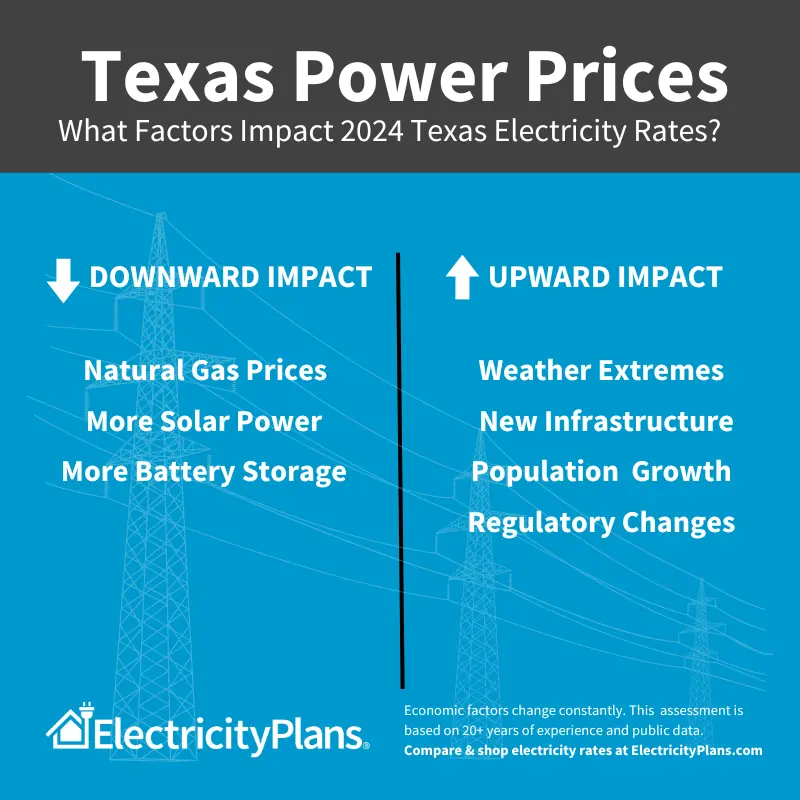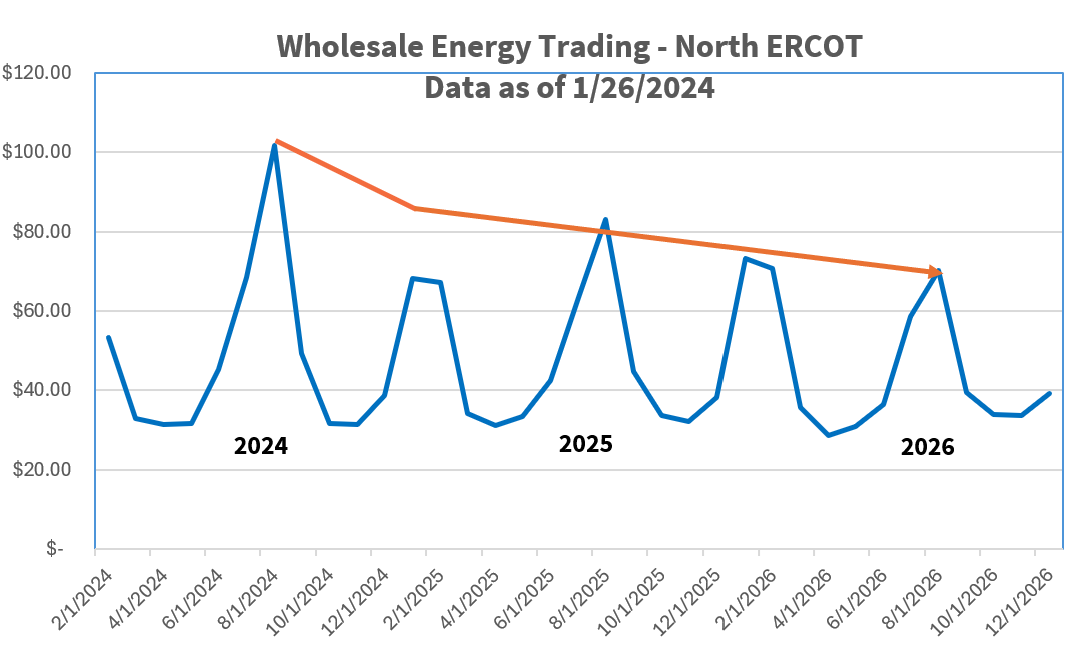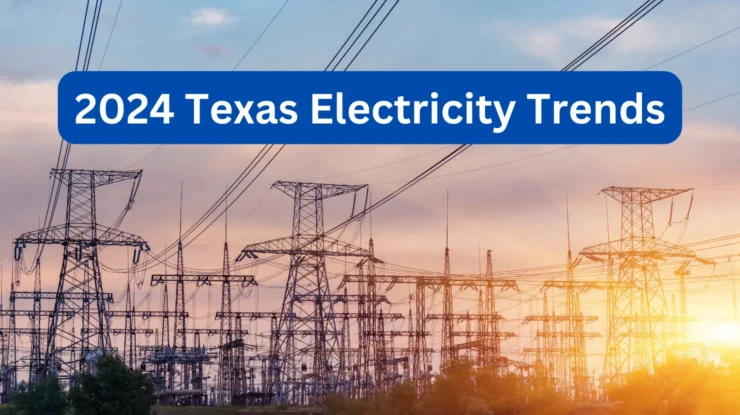Texas electricity rate trends for 2024 show prices similar to 2023. Here’s our Texas electricity rates trend forecast, key factors driving electricity prices and what types of electricity plans will be popular this year.
Key Takeaways:
- Texas electricity prices for 2024 will continue at levels seen in 2023. Residential electricity rates will average 14-16¢ per kWh including delivery costs.
- Longer term contract terms (24 to 36 months) will be the cheapest electricity options.
Jump right to the cheapest electricity plans in Texas or read on for our trends and price forecast.
Texas Electricity Rates in 2024 – Average Price

- Average electricity rate in AEP Texas Central: 15.98¢ per kWh
- Average electricity rate in AEP Texas North: 17.15¢ per kWh
- Average electricity rate in CenterPoint Energy: 15.99¢ per kWh
- Average electricity rate in Lubbock Power & Light: 17.76¢ per kWh
- Average electricity rate in Oncor: 16.03¢ per kWh
- Average electricity rate in TNMP: 17.28¢ per kWh
Factors That Drive Texas Electricity Rates
There are a number of key factors that drive Texas electricity prices. Our assessment is based on 20+ years of experience in the electricity market plus input from industry professionals.
- Natural Gas Prices. Natural gas prices drive electricity costs because (a) natural gas accounts for 45% of electricity production in Texas and (b) these more expensive generation resources often set the marginal cost of power. Natural gas prices are low after hitting historic peaks in 2022 and 2023. But electricity prices in Texas haven’t dropped due to other factors.
- Regulatory Changes. ERCOT implemented market structure changes after 2021’s Winter Storm Uri to increase grid stability. New ancillary services fees increase wholesale costs and your price. Uncertainty around whether these regulatory costs can be passed through to consumers makes REPs add a premium to their pricing.
- Supply & Demand. Texas’ demand for electricity has increased almost 20% in the last 5 years. That’s driven by population growth, increased manufacturing and data processing centers, and weather. On the supply side, Texas voters approved $7.2 billion in low interest loans from the PUCT to entice new gas-fired generation. But building such resources can take years. Most new generation in 2024 will come from solar and battery storage.
- Weather Patterns. 2023 was the second-hottest year on record for Texas. Plus we’ve had a pattern of winter storms since 2021. Texas weather extremes drive higher electricity prices in summer and winter.
- Changing Generation Mix. Wind and solar now provide nearly 1/3 of our power. This lower cost electricity generation pushes wholesale prices down, but transmission costs to get the power to population centers could increase delivery fees.
- Market Consolidation. Two consecutive hot summers and new market costs have taken a heavy toll on independent REPs, what we call “fighter brands.” Consolidation in an industry often leads to less price competition and higher rates.
One big item that affects the price you pay? When you shop. Certain seasons — Spring and Fall — are the best time to shop for electricity in Texas.
Another issue that increases your bill? Letting your contract expire and roll to a variable rate. Sign up for our free electricity contract reminder service and never forget again!
Shop Texas Residential Electricity Rates by Zip Code

Texas Electricity Plan Trends for 2024
Changes in the marketplace are having an effect on the products being offered. Here’s what we expect to see in 2024 for Texas’ popular electricity plans.
- Fixed rate electricity plans will continue to be the most popular type of electricity plans in Texas. That’s because no nonsense, no gimmicks basic electricity plans offer the best value for most consumers.
- Electricity plans that pay consumers to reduce consumption will become more popular as ERCOT calls on demand response to help the grid.
- Consumers who install solar panels will have more options to sell power back to the grid, but the price they receive will be lower then they expected, driving a longer investment payback.
- Time of use plans will emerge to match new ERCOT supply curves. More solar and wind on the grid means lower priced daytime electricity, higher priced evening power and cheap nighttime electricity. Rhythm Energy’s PowerShift is one such time of use plan plan.
Short Term vs. Long Term Power Contacts in 2024
Following trends that we’ve seen for the past 2 years, long term contracts will provide the best value in Texas electricity rates in 2024.
That’s not to say there won’t be opportunities where short term contracts offer a great rate. In fact, if you see an odd-term contract (like 8, 11, 14 months etc), take a good look. Odd-term contracts are created to take advantage of market prices.
But right now, wholesale electricity prices for 2024 electricity are trading at a premium. Wholesale contracts for 2025 and 2026 power are less expensive. That means you’ll likely get a better rate with a 24 or 36 month plan vs. a 12 month plan.

Shop Texas Electricity Rates by Zip Code
Texas Electricity Trends FAQs
Texas electricity prices for 2024 will continue at levels seen in 2023. Residential electricity rates will average 14-16¢ per kWh including delivery costs in 2024.
The Texas long-term electricity price forecast for 2025 looks positive based on ERCOT reserve margins. However, that can change based on regulatory concerns, market jitters and weather. Residential customers can protect their electricity rate for 2025 by securing a 2 or 3 year electricity contract now.
Electricity prices in Texas have increased 20% over the last 5 years, according to data from the EIA. Higher prices are driven by increasing population, regulatory changes, weather conditions and aging infrastructure.
The best time to shop for electricity rates in Texas is spring and fall. Rates are historically at their lowest in April, May and October. And rates are typically highest in July, August, January and February.
ERCOT forecasts a 2024 peak demand of 86,130MW. As a comparison, ERCOT hit a record peak demand of 85,508MW on August 10, 2023. Peak demand is the highest amount of electricity used in a given time period. ERCOT stands for Electric Reliability Council of Texas, and they are a non-profit organization that manages the state’s electrical grid.
As more large-scale solar generation assets come online, you can expect more of our 2024 power to come from renewable resources. One industry source projects that 38% of Texas power will come from wind and solar in 2024. As a comparison, in 2023 31% of all electricity in Texas was generated from renewable energy.
